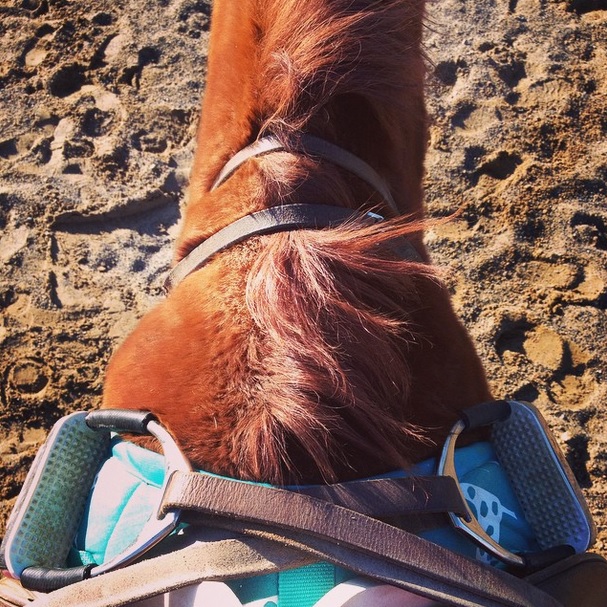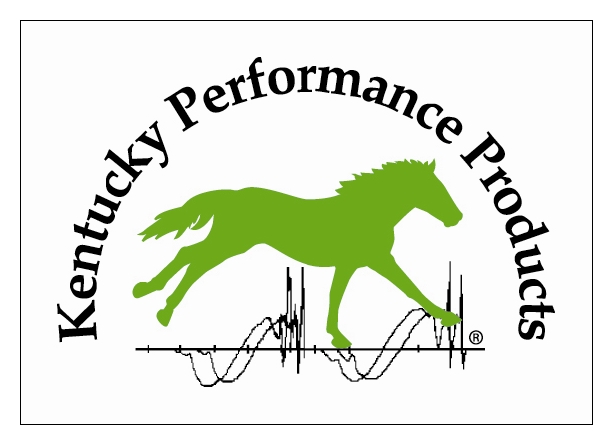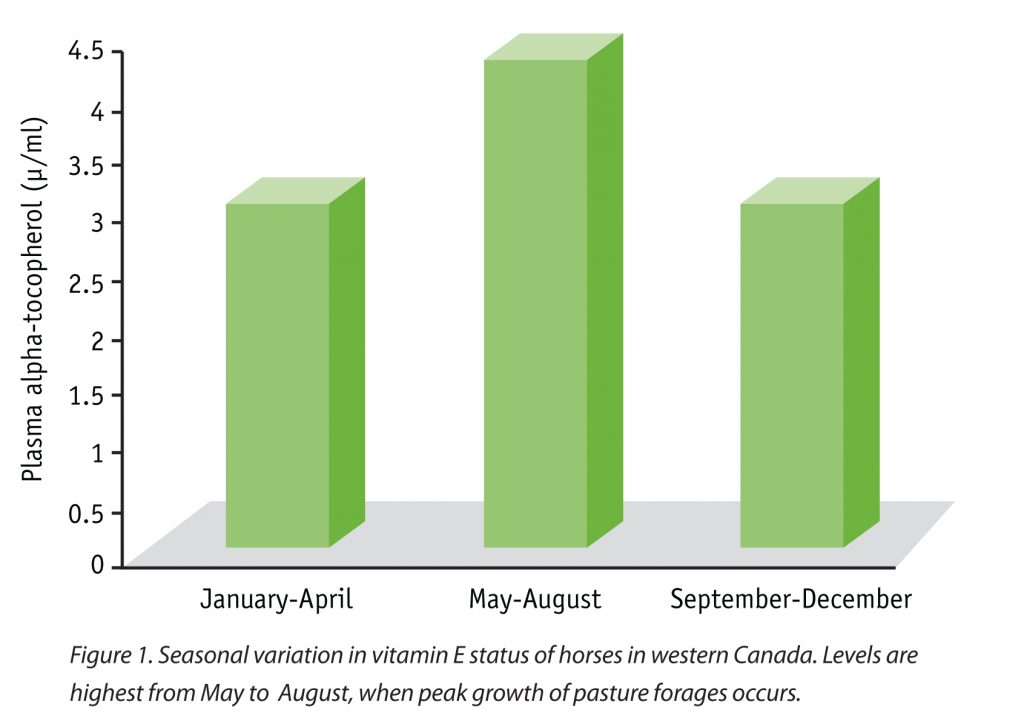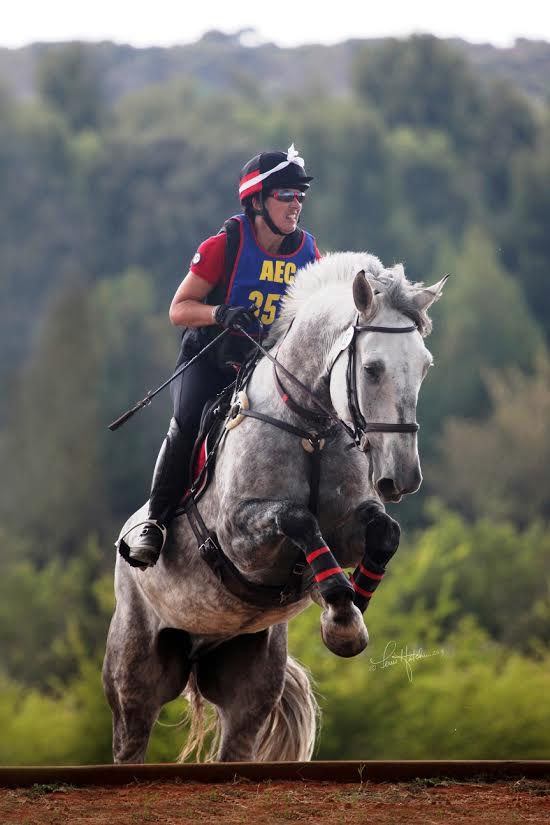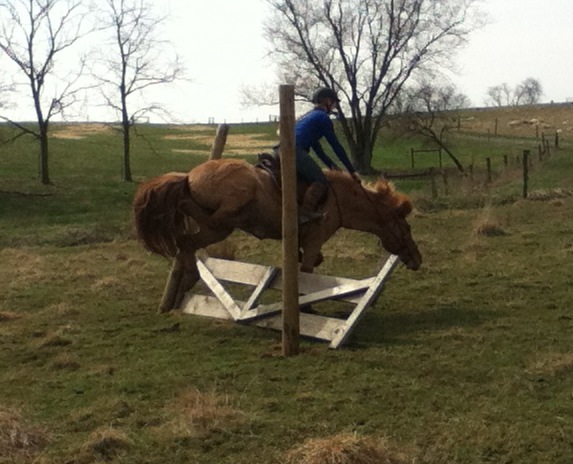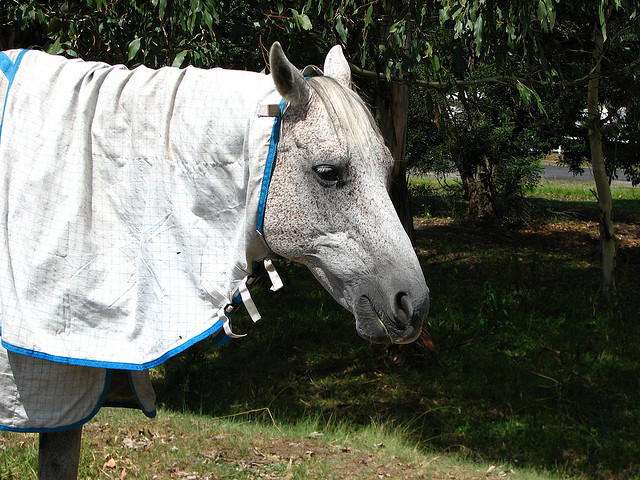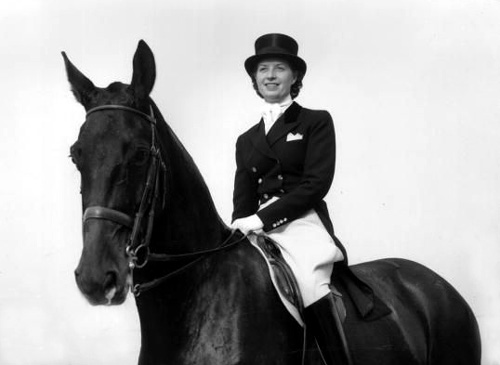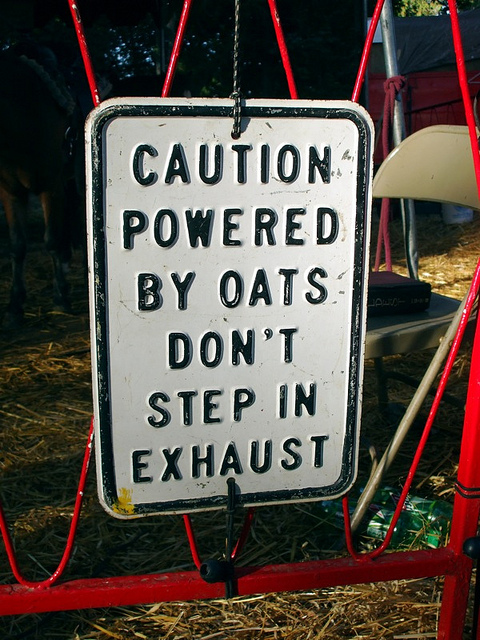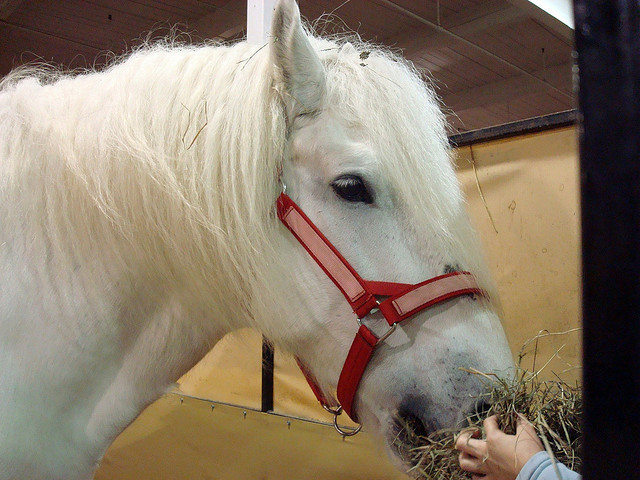Leslie Wylie
No-Stirrup November Support Group: The Final Countdown
Who’s ready for this thing to be over? (more…)
Postcard from the Blizzard in Buffalo
Photographer Megan Stapley sent us these stunning images from her farm in East Aurora, New York, near Buffalo which was hit with a record-breaking snowfall this week. (more…)
Kentucky Performance Products Nutritional Minute: Vitamin E
Kentucky Performance Products gives us the skinny on one of the most important nutritional building blocks in your horse’s diet: Vitamin E.
F A S T F A C T S
Vitamin E is an essential nutrient for horses
Vitamin E cannot be synthesized by the horse; therefore, it is considered an essential nutrient. The best source of vitamin E is fresh green grass; however, the potency of vitamin E declines very quickly once forages are harvested and dried.
Vitamin E requirements vary from situation to situation. Multiple research studies have shown that vitamin E is often deficient in the diets of horses that do not have access to continual grazing on fresh green grass, or those grazing on winter pasture.
Performance horses with demanding workloads, growing horses and seniors can be exposed to increased levels of oxidative stress and therefore require higher levels of vitamin E in their diets. Studies reveal that horses challenged by neurological disease benefit from supportive natural vitamin E.
T I P S A N D T O P I C S
Researchers Confirm Vitamin E Lower in Horses Without Access to Pasture
Horses are managed in varying conditions throughout the world. A vast number of them do not have access to growing pasture year-round due to geographic region, season, training schedules, or specific management routines. Because of their limited intake of fresh forages, these horses do not consume sufficient vitamin E for optimal health. Insufficient vitamin E in the diet can lead to muscle problems and impaired immune function.
Canadian researchers have confirmed a long-held suspicion among equine nutritionists that horses may need additional vitamin E when not consuming fresh, high-quality pasture grasses (Blakley et al., 1994).
Proper supplementation with a natural vitamin E product such as Elevate® ensures that horses are properly nourished when they cannot spend considerable time grazing fresh pasture.
Key Points of the Study
Procedure: Over a two-year period, researchers at the University of Saskatchewan studied about 400 healthy horses to determine normal levels of vitamin E. Using horses from 24 locations in Alberta and Saskatchewan, researchers collected blood samples and recorded important information about each horse including diet, sex, and age.
Results: Blood samples showed that levels of vitamin E were highest from May to August when compared to other times of the year, as shown in Figure 1: Seasonal variation in vitamin E status of horses in western Canada. Levels are highest from May to August, when peak growth of pasture forages occurs.
Interpretation: The increase in vitamin E levels corresponded to the months in which horses in western Canada consumed feeds containing high levels of naturally-occurring vitamins, namely pasture. Horses consuming only fresh pasture during the summer months had plasma vitamin E concentrations that were 63% greater than horses fed harvested, dried, or pelleted feeds during the same time period.
Recommendations
This confirmed the widely held opinion that green grass is the greatest source of vitamin E. In winter months or throughout periods of stall confinement such as during training, showing, or lay-up, fresh pasture is often not an option. In such cases, horses should be supplemented with a natural vitamin E supplement such as Elevate.
Proper nutritional management of young horses is especially important. The researchers pointed out, “During periods of rapid growth the nutritional demand for vitamins is high, so it is not surprising that young, rapidly growing horses have a lower vitamin status than older horses.” When these young animals are receiving all of their nutrition from processed feeds, their nutritional well-being may be compromised, which may ultimately lead to health problems.
In looking for a vitamin E supplement, be choosy. Select one that contains natural vitamin E (d-alpha-tocopherol). Natural vitamin E is superior to synthetic vitamin E because of its ability to be absorbed quickly from the gastrointestinal tract, hitting target organs faster.
References
Blakley, B.R., & Bell, R.J. 1994. The vitamin A and vitamin E status of horses raised in Alberta and Saskatchewan. Can. Vet. J. 35:297-300.
Pagan, J.D., Kane, E., & Nash, D. 2005. Form and source of tocopherol affects vitamin E status in Thoroughbred horses. Pferdheilkunde 21:101-102.
I N T H E S P O T L I G H T
Natural Vitamin E During the Winter Months
Click here for a larger image.
Article written by KPP staff.
Copyright (C) 2012 Kentucky Performance Products, LLC. All rights reserved.
Article sponsored by Elevate Maintenance Powder; an affordable, easy way to provide essential natural vitamin E, when longer-term vitamin E supplementation is needed.
When health issues arise, always seek the advice of a licensed veterinarian who can help you choose the correct course of action for your horse. Supplements are intended to maintain healthy systems and support recovery and healing. They are not intended to treat or cure illness or injury.
About Kentucky Performance Products, LLC: Since 1998, Kentucky Performance Products has simplified a horse owner’s search for research-proven nutritional horse supplements that meet the challenges facing modern horses. KPP horse supplements target specific nutritional needs and are formulated to complement today’s feeds, thus safeguarding against over-supplementation. Each product is scientifically formulated and made with high-quality ingredients at certified manufacturing facilities. Kentucky Performance Products is proud to offer a quality assurance promise backed by a money-back guarantee. Kentucky Performance Products brings you horse supplements you can count on because the horse that matters to you, matters to us.
Meet Romeo, the Steer Who Has No Idea He’s a Steer
Moo-ve over, horses. I think I’m in love.
Horse Haikus of the Day, by Harley Cozewith
Horse life in 17 syllables.
Standing Ovation of the Week, Presented by Ovation Riding
This week’s honoree: Horse Tales Literacy Project.
Best of Craigslist: ‘Very Rare Reindeer’ Edition
Someone is trying to sell Rudolf on a horse sales website. For a million dollars.
Horse Haikus of the Day, by Victoria Lachelle Henderson
Horse life in 17 syllables.
Today’s haikus are brought to you by reader Victoria Lachelle Henderson, who explains, “OK, I had entirely too much fun with these while I was bored at work… some are bad. Some are REALLY bad.”
….
Trainer says: no bling.
But I like tack that sparkles.
Glitter all the things!
…..
The first jump on course:
Long approach, single oxer.
Jesus, take the wheel.
…..
Trainer says: heels down.
Shoulders back. Thumbs up. Wrists straight.
Don’t forget to breathe.
…..
Trainer says: count strides.
One, Two, Three, Oops. Big long spot.
Pray I don’t fall off.
…..
Trainer says: more leg.
But my horse is so lazy.
Go, horse! My legs hurt.
…..
We love them all, Victoria! One more for ya from all of us here at Horse Nation…
Send us your haikus
5-7-5, it’s easy
Horse Nation needs you
Email your own horse haiku (a three-line poem with 5-7-5 syllables per line) to [email protected]. Include a photo of your haiku’s equine inspiration if you like!
Go Riding.
‘Just One More’ Dog Jumping Photo Post, Volume IV
SO MUCH CUTE. MAKE IT STOP.
SpectraVET Performance of the Week: Eitan Beth-Halachmy & Santa Fe Renegade at the 2014 Cowboy Dressage World Finals
Watch the founder of Cowboy Dressage (motto: “When dressage suits your needs but a Stetson suits your lifestyle”) show us how it’s done.
Keep the Cold Out & the Fun In With These Winter Helmet Snuggies
Etsy shop HeatherWear can custom make you the helmet cover of your wildest dreams.
Horse Haiku of the Day, by Melissa Owens
Horse life in 17 syllables.
True Story: I Spayed My Mare
After ruling out Regumate and uterine implants, Amanda Moretz decided to have her “marish” mare, Gracie, spayed. Five years later Gracie is happy and pain-free, and they’ve never looked back since. (more…)
Horse Haikus
Horse life in 17 syllables. (more…)
Tuesday Video From Dubarry: Come On In, the Water Is Fine!
When Anna Paterek shared a video of her horse, Magic, getting over his apprehension about a creek crossing on Facebook, she probably didn’t expect it to go viral.
Olympic Girl Power: The Incredible Story of Lis Hartel
Lorraine Jackson recounts the life of a woman who not only helped break the gender barrier of Olympic-level equestrian sport, but did so while completely paralyzed from the knee down.
5 MORE Reader-Submitted Canine Jumpers
Horse Haikus: Manure Edition
Sorry about the crappy poetry.
The 15 Greatest ‘Onion’ Horse Headlines of All Time
We’re an easy bunch to make fun of, apparently.
SmartPak: How To Wrap a Horse’s Leg
Check out the latest handy how-to video from our friends at SmartPak!
From SmartPak’s YouTube channel:
Wrapping a horse’s legs is something that all horse owners may need to do at one time or another, so knowing how to put polo wraps on a horse, how to bandage a horse’s legs for trailering or shipping, and how to wrap a horse’s legs with quilts are important skills to have. Plus, knowing which bandage or wrap to use – polo wraps, quilted leg wraps, no bow wraps, standing bandages, shipping bandages or travel bandages – is essential knowledge, too.
Watch as Dr. Lydia Gray gives common sense tips on how to apply leg wraps to a horse.
Got it. Need leg-wrapping supplies?
From traditional quilts…
…and bandages…
….to cutting-edge leg wrap technologies…
… SmartPak has your hookup here.
Go SmartPak and Go Riding!
The Problem With Easy Keepers, Part II
Is your horse battling a metabolic disorder? Jody Webb lends some insight into holistic treatment.
If you missed Part I, click here.
Helping the EMS (Equine Metabolic Syndrome) Challenged Horse
By Jody Webb
It is no secret that metabolic disorders are on the rise in the horse world. Whether through the poor breeding management or through the overuse of chemicals in vaccines, wormers, feeds or a combination thereof the “tough as a mustang” type of horse has pretty much been left only to the… well, mustangs.
On the rise is PSSM (Polysaccaride Storage Myopathy), IR (Insulin Resistance), Cushings (tumor on the pituitary gland), HYPP (Hyperkalemic Periodic Paralysis) which have side effects such as the “easy keeper,” the “hard keeper,” tying up, chronic colic, “cresty neck” and laminitis to name a few. With the exception of HYPP (which is its own complicated diet), all of these other syndromes benefit from the same basic type of diet. The PSSM horse also benefits from the same diet outline, though rations will vary greatly from horse to horse.
- Reduced or zero grazing, especially on spring and fall grasses which can be high in sugars
- Low sugar hays fed in slow graze hay bags which helps to balance insulin levels
- Introduction of a balanced level of HEALTHY omega 3 fatty acids and amino acids which improves insulin balance and provides many vital nutrients
- Removal or severely limited grain products that add to unnecessary calories
- Removal of “complete” feeds that incorporate molasses as an ingredient
- Removal of as many chemical additives as possible, i.e. as natural and organic a diet as possible for easily uploadable nutrients
- Severely limited or zero use of vaccines, chemical dewormers, and other chemically based medications that can interfere with the body’s functions — functions that are already challenged for the EMS horse
- Careful introduction of herbs as supplements to help balance the body and cause it to function more “normally”
The point of the diet is not to heavily restrict calories (as some suppose) but to use the right TYPE of calories. Sugars and starches are calories that are stored as body fat if not immediately used, which leads to problems with the metabolically challenged horse. As hay is already a starch, but nutritionally limited, it is then important to provide foods that are low in sugars and starches but provides a vast amount of nutrients as well. So what are options for those nutrients?
- Herbs that aid in balancing sugar levels as well as providing vitamins and minerals promoting digestion, increasing circulation, boosting function of the thyroid and adrenals, and aiding in balancing hormones such as fenugreek, ginger, oregano, rosemary and cinnamon. (Note: Caution must be used with the HYPP and PSSM horses as their particular syndromes must be carefully considered before choosing certain herbs.)
- Kelp has been shown in studies to not only provide a vast array of nutrients but also has shown to help balance sugar levels.
- Healthy fat foods such as flax seed, camelina meal, coconut meal and their corresponding oils are useful in controlling sugar spikes plus supplying the body with a variety of amino acids. Amino acids are noted in many studies to help balance sugar levels.
With consideration to the individual horse and a careful diet plan, these horses can live a long and healthy life. In fact this same basic diet outline is beneficial to the health of all horses! Choosing foods that are as close to “natural” as possible, limiting carbohydrates and removing excess sugars, introducing healthy fats and adding herbs that both aid in regulating body functions as well as providing minerals and especially vitamins that are often missing in the equine diet, will lead to a happier, healthier and more balanced horse.
Jody Webb is the “Solepreneur” of AverageJo Equine, with a line of all natural supplements for horses and dogs. Her Wild Horse and Wild Dog line of products is the focus of years of research with the goal of taking your pets away from chemical laden feeds and supplements and taking them back to as close to nature as is possible in a tamed environment. With her three horses, two dogs, two cats, various rescue horses and their individual issues, there are plenty of willing volunteers with which to perfect each product. This desire came upon finding her then new horse Gideon was suffering from a metabolic disorder called EPSM. Though this disorder can never be cured and there will always be lifelong health issues for Gideon, he has gone from a cranky, underweight and severely in pain train wreck to a sassy and healthy looking beast! Jody is now taking her knowledge learned from owning such a difficult animal to moving on and helping other horse and dog owners have healthier, happier pets. Her writing comes out of the joys and pains of owning such a challenging animal. Learn more about all-natural horse products at Jody Webb’s blog, WildHorseProducts.com.






